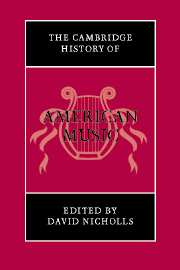Book contents
- Frontmatter
- PART ONE
- PART TWO
- 10 Music in America: an overview (part 2)
- 11 Immigrant, folk, and regional musics in the twentieth century
- 12 Popular song and popular music on stage and film
- 13 The rock and roll era
- 14 Ragtime and early jazz
- 15 Jazz from 1930 to 1960
- 16 Jazz since 1960
- 17 Tonal traditions in art music from 1920 to 1960
- 18 Serialism and complexity
- 19 Avant-garde and experimental music
- 20 Tonal traditions in art music since 1960
- Bibliography and references
- Index
- References
16 - Jazz since 1960
from PART TWO
Published online by Cambridge University Press: 28 March 2008
- Frontmatter
- PART ONE
- PART TWO
- 10 Music in America: an overview (part 2)
- 11 Immigrant, folk, and regional musics in the twentieth century
- 12 Popular song and popular music on stage and film
- 13 The rock and roll era
- 14 Ragtime and early jazz
- 15 Jazz from 1930 to 1960
- 16 Jazz since 1960
- 17 Tonal traditions in art music from 1920 to 1960
- 18 Serialism and complexity
- 19 Avant-garde and experimental music
- 20 Tonal traditions in art music since 1960
- Bibliography and references
- Index
- References
Summary
Introduction
One of the most compelling portrayals of jazz develops from the theme of the downtrodden hero. According to this narrative, jazz, as an anthropomorphism of black survival – America’s “living art” - endures a precarious existence, trapped within a plebeian and often hostile commercial environment. For a time, the hero narrative worked successfully to perpetuate beliefs in the music’s historical and aesthetic coherence. Jazz endured, it seemed, despite the wide range of styles and practices that had emerged since its “birth” in the “cradle” of New Orleans. By the late 1950s, however, many observers had begun to suspect that something was seriously wrong with the musical body, jazz. Having taken for granted its ties to a market economy that required a constant flow of new stars, taste makers and pundits feared that jazz might soon die off unless a new figure of vision could provide a clear stylistic direction. Musical activity in a real sense had not subsided, of course. Journalistic coverage from the period shows that musicians actively performed and recorded in an array of styles, from New Orleans ensemble improvisations to gospel-inflected soul jazz, from “third stream” (a hybrid of jazz and European-based art music) to energetic extensions of bop (Lees 1960). Yet the expectations of innovation, exacerbated by market pressures, led many to believe that any lapse in discernible stylistic growth was a sure sign of a coming “death.” As a matter of course, critics and audiences looked hopefully to that next “Great Man” who would build a new kind of jazz based on prior practices.
- Type
- Chapter
- Information
- The Cambridge History of American Music , pp. 448 - 470Publisher: Cambridge University PressPrint publication year: 1998



